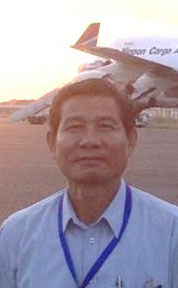Asura International Seminar
Friday February 27th, 2015, 13:30-15:30
2015年2月27日(金) 13:30-15:30
Seminar room at WRC, Kyoto Univ.
野生動物研究センター 地下1階 セミナー室
WRC/PWS special seminar
Deeping Japan-Laos Friendship through Lao Elephant Breeding Project
Talk 1

Prof. Houngphet CHANTHAVONG
Dean of Faculty of Forestry, National Univ. of LaosLao forest resources management toward sustainable forest management
Lao PDR is still heavily forested by regional standards, with wildlife and non-timber forest products providing a vital source of subsistence and cash income for an impoverished rural population. Over the past few decades, these resources have become seriously depleted. There has been an increasing degradation and destruction of the natural forest. The total area of forest dropped dramatically from 70% of the land area or approximately 17 million hectares in 1940, to 11.6 million hectares in 1982, and to only 41% (about 9.8 million hectares) in 2002. In recent years, the Government of Laos introduced a number of policy instruments and incentives to boost forest cover by promoting forest restoration plan and the development of forest plantations throughout the country.
This article provides overview of the forest resource based in Laos and examines evolution in forest and plantation development from the perspective of broader historical development. The key rivers of deforestation and Degradation, including the policies, internal, and external forces driving forest management in Laos are also discussed.
Pragmatically, this paper also presents the role of the forestry education in Laos in supporting the sustainability of forest in Laos. Furthermore, it also presents the result of the assessment of the current curricula and syllabi of Laos universities and colleges against current and future tasks of the sector such as the Laos Forestry Strategy 2020, the ASEAN Criteria for Sustainable Forest Management, current topics like REDD+ and FLEGT. In the conclusion, the paper pointed out how the Lao Forestry agencies have set up the mechanisms how to well prepare for ASEAN 2015 integration.
Keywords: Lao Forest, Forest policy, Lao education, ASEAN, LaosTalk 2

Mr. Saysamone PHOTHISAT
Deputy Director of DFRM, MoNRE, Lao P.D.R.Elephant Population status in Lao People's Democratic Republic
The Lao People’s Democratic Republic is a landlocked country located in the center of the China, Vietnam, Cambodia, Thailand and Myanmar. It has a total land area of 236,800 km2 with an estimated population of just over 6, 7 million people (2013) and a population growth rate of 2.3%.
Historically as Lane Xang state, or “the State of a Million Elephants”, Lao PDR had large populations of both wild and domesticated elephants in the past. The elephant has played an important cultural and religious role for centuries, and its symbolic importance continues to be recognized across the country. Elephants are generally viewed in a positive light, even in rural areas where land use conflicts occur. Elephants are a very important natural and cultural asset to Laos people, so we intend to do all that we can to ensure elephants survive in the wild.
Asia Elephant is very large mammal with a long trunk. Generally dark brown or grey body, but paler when dry and darker when wet. Weak eyeshine. The habitat is Favours mixed deciduous forest, but also found in evergreen forest at lower densities. Often found in close proximity to rivers. Salt licks are of vital importance. Occurs throughout the country, but range much fragmented and population much decreased. Still a heavily forested Southeast Asian nation, Laos is coming under increasing pressure to exploit its abundant natural resources, particularly the large forest areas on the borders with neighbouring Cambodia, Thailand, China, and Vietnam.
Lao PDR has a serious lack of capacity for wildlife conservation. There are not enough staff and inadequate training, leading to a massive shortage of expertise. This in turn, has resulted in a serious lack of data and information on elephant distributions, numbers, and population trends in the country. Conversion and degradation of elephant habitat, Habitat degradation due to the presence of livestock, invasive plants, extensive fires, and fuel wood collection.
In recent years there have also been increased incidences of human-elephant conflict (HEC) including crop raiding, destruction of property, and fatalities. There is little information available on the origin of the conflict or on the cost of the crops that are affected. HEC is a serious stumbling block for elephant conservation because it causes animosity between elephants and villagers and in many cases, villagers will take matters into their own hands, often with disastrous consequences for the elephants.
The elephant conserve and manage by legislation such as the aquatic and wildlife law, forestry law, decree, regulations and other related law.
National Elephant Management Action Plan should be protect the Elephant habitat and protected area improvement, Elephant population Monitoring and distribution study and Improve legal and regulatory Framework and the Law enforcement patrol and elephant monitoring.
Elephant is an animal unique Lao state of which their used to communication of cultural discrimination between countries. The establishing diplomatic relationship between Lao PDR and Japan 60th year anniversary, Lao government gave the present to the Japanese government to 4 elephants for exchanges in cultural, education, research and breeding of Asian elephants.
Lao PDR has established the treatment centre of elephants in the Xayaboury province for treat the wounded’s elephants and small elephant mother’s death. The centre treatment is a small, lack of funding support, equipment and service personal with experience.
Lao has now the requisite institutions and will soon have the appropriate legislation for the management of wildlife and nature. They mostly have a forestry/biology background but low experience in wild life and protected area management